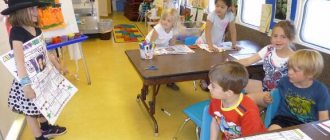Article:
Constructive activity is a practical activity aimed at obtaining a specific, pre-conceived real product that corresponds to its functional purpose.
Design has extremely wide possibilities for mental, moral, aesthetic, and labor education. Children's construction is usually understood as a variety of buildings made from building materials, the production of crafts and toys from paper, cardboard, wood and other materials. In its nature, it is most similar to visual activity and play - it also reflects the surrounding reality. Children's buildings and crafts are for practical use (buildings for play, crafts for decorating a Christmas tree, for a gift for mom, etc.), and therefore must correspond to their purpose.
There are two types of children's design: technical and artistic.
In technical design, children mainly display real-life objects, and also come up with designs by association with images from fairy tales and films. At the same time, they model their main structural and functional features: a building with a roof, windows, a door; a ship with a deck, stern, steering wheel, etc.
The technical type of design activity includes: design from building material (wooden painted or unpainted parts of geometric shape); from designer parts with different fastening methods; from large-sized modular blocks.
In artistic design, children, when creating images, not only (and not so much) display their structure, but express their attitude towards them, convey their character, using such a technique as “violation” of proportions, as well as color, texture, shape: a cheerful clown , a thin simpleton wolf, a handsome prince, etc., which leads, in the words of A.V. Zaporozhets, to “the formation of unique emotional images.”
The artistic type of design includes design from paper and from natural materials.
Construction is a productive activity that meets the interests and needs of preschoolers. Children use the created buildings and crafts in games, in theatrical activities, and also as gifts, decoration of premises, grounds, etc., which brings them great satisfaction.
Children's design, and especially technical, is closely related to play activities. Children build buildings (car garage, knight's castle, etc.) and play with them, repeatedly rebuilding them during the game.
Taking into account the features of play and design, their relationship is necessary when determining the forms and methods of organizing these different types of children's activities. Thus, the requirements for the quality of structures erected even by older children during role-play are unjustified, since this can destroy it. And vice versa, to be content with primitive children's buildings and crafts and not to purposefully develop full-fledged construction as an activity means to significantly impoverish the development of children.
Construction classes develop children's sensory and thinking abilities.
According to T.V. Luss, with properly organized activities, children acquire:
- constructive and technical skills:
- construct individual objects from building materials - buildings, bridges, etc.;
- make various crafts from paper - Christmas tree decorations, boats, etc.;
- generalized skills:
- purposefully look at objects
- compare them with each other and divide them into parts,
- see the common and different in them,
- find the main structural parts on which the location of other parts depends,
- make inferences and generalizations.
It is important that children’s thinking in the process of constructive activity has a practical orientation and is of a creative nature. When teaching children to design, planning mental activity develops, which is an important factor in the formation of educational activity. When children design a building or craft, they mentally imagine what they will be like and plan in advance how they will be completed and in what sequence.
According to L. A Paramonova, constructive activity contributes to practical knowledge of the properties of geometric bodies and spatial relationships:
- children’s speech is enriched with new terms and concepts (bar, cube, pyramid, etc.), which are rarely used in other types of activities;
- children practice the correct use of concepts (tall - low, long - short, wide - narrow, large - small), in precise verbal indication of direction (above - below, right - left, down - up, behind - in front, closer, etc.). d.).
Constructive activity is also a means of moral education of preschool children. According to L.A. Wenger, in the process of this activity important personality qualities are formed:
- hard work,
- independence,
- initiative,
- perseverance in achieving goals,
- organization.
Joint constructive activities of children (collective buildings, crafts) play a big role in developing the initial skills of working in a team:
- the ability to negotiate in advance (distribute responsibilities, select the material necessary to complete a building or craft, plan the process of their manufacture, etc.);
- work together without interfering with each other.
However, constructive activity acquires such a multifaceted significance in raising children only if systematic training is carried out and a variety of methods are used aimed at developing not only constructive skills, but also valuable qualities of the child’s personality and mental abilities.
Construction and imagination
Imagination is an important quality for each of us! It is on a par with such qualities as creativity, imagination, and the ability to think outside the box. Why do we need it? Why is this so important?
The thing is that imagination is an indispensable component of a successful person and a creative person these days.
A person without imagination is unlikely to achieve much success in life. And his life, most likely, will be boring, without a creative component.
In the age of robotization of production, more and more operations are performed by robots. Today, a robot bricklayer, a robot taxi, and a robot banker have already been created. Smart machines are gradually replacing people in various fields of activity and they are losing their jobs.
But what robots cannot do and what they will never learn is creativity. For example, the same robot does not and cannot have imagination.
Therefore, a creative person will always be in demand and there will always be work for him.
So what to do if a child (or even an adult) does not have a developed imagination?
It turns out that getting this ability is quite simple!
Construction has a powerful influence on the development of a child’s creative abilities. Moreover, stimulating the imagination during the design process is a proven fact.
Moreover, with the help of a designer, not only a child, but also an adult can become a person with a rich imagination!
This time we will talk in more detail about how to use constructors and develop with their help.
Construction as a development stimulus for a child
Construction really helps solve some problems and gaps in development. It will also help to discover numerous talents, including developing imagination and creative qualities. The most important condition for this is the game!
Design should not become a duty, a responsibility, a lesson. This game is an ideal activity, interesting and not boring for both children and adults.
It is extremely important that children have access to a wide variety of construction toys. The more there are, the more possible options, the wider the field for imagination. By constructing, a person constantly improves his thought processes, his imagination, fantasy, and creativity.
The wonderful influence of Lego on a child's development
In this regard, the story of my friends’ son is very indicative. The boy lagged behind his peers, including in terms of abilities. Even completing assignments in kindergarten was difficult for him. He didn't want to write and draw, sculpt and take tests. Everything caused furious protest!
And then his wise dad bought his son several construction sets. It was both traditional Lego and new, more complex variations on the theme. Dad and son designed together, and they were fascinated by the activity!
After some time, the boy became more diligent and began to show interest in mathematics. He knew very well how to make a model following the instructions. Moreover, I began to come up with my own models! By the first grade, it became clear that he was a smart, quick-witted child with a well-developed imagination.
The benefits of construction for children
Almost all children and almost all adults love to design. It’s just that not everyone admits it! Modern psychologists believe that the love of design is inherent in us as an instinct.
Designers give us, first of all, the development of imagination and creative thinking.
The peculiarity of construction kits is that they usually come with assembly diagrams and instructions. And this, oddly enough, is not always good. But even assembly instructions do not prevent children from developing!
Very soon they get tired of following the schemes, and their imagination and fantasy burst out! Children get creative and come up with their own, sometimes very strange and unusual, objects.
Along the way, they create new things, create, analyze, plan, and act consistently. All this is extremely important for their life as well as their studies.
Influence of designers:
- they provide spatial imagination;
- the ability to understand the properties of geometric shapes;
- help to understand concepts such as shape, size;
- develop imagination, creativity, creativity;
- help to use directions;
- and, finally, they develop independence, perseverance, and hard work - without this, even the most vivid imagination will not result in a worthy result.
Main types of construction sets for children
- Cubes are a real “classic”, a primitive but effective construction set for kids. It introduces shape, color, texture. And it makes it possible to come up with your own models, albeit primitive ones.
- Inserts help to learn how to compare the shapes and sizes of elements, but practically do not develop imagination.
- Mosaic - develops imaginative thinking, because from it you can assemble your own, real picture!
- Block type constructors. You can create anything from these, give free rein to your imagination! You can make houses, airplanes, rockets, whatever!
- Lego is the maximum advantage of a regular construction set, plus the possibility of more complex 3D modeling, consisting of hundreds and thousands of parts. There are practically no limits to the imagination, because here you can make any fantasy come true!
By the way, it is free design (without instructions, tips and diagrams) that opens up the opportunity for children and adults to think outside the box. And also - give free rein to your imagination, fantasize from the heart.
That's all! Develop your imagination and other important skills. And design for your own pleasure, no matter whether you are a child or an adult. Be sure to subscribe to updates on this channel to receive even more important, useful information.
Comments here are also very welcome. If you think this article might be useful to your friends, please share it on social networks. Good luck to you!
Facts and Research
Interesting fact. At the end of the nineteenth century, very realistic construction sets that recreated houses began to be produced in Germany. It was called Anker-Steinbaukasten. These were “stone” blocks made from a mixture of chalk and quartz.
From them you could collect copies of buildings, or come up with your own versions. This is exactly the kind of designer Max Born, Albert Einstein, and Robert Oppenheimer had. And these people cannot be denied a lack of imagination, do you agree?
Numerous studies by scientists confirm that methods and techniques based on construction perfectly develop not only the imagination. This list also includes: fine motor skills, mathematical abilities, independence, speech, logic. And most importantly - interest in creating new things, and creativity!



